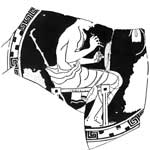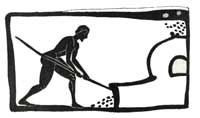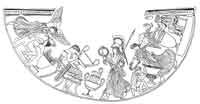Part 2
Pottery from Greece 8000 years history
Neolithic Pottery from the Franchthi Cave Excavations: 6000 BC
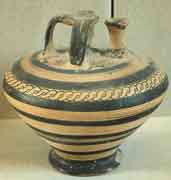
Mycenaean stirrup vase Louvre AO19201
Creta, Mycenae: 3000-1100 BC (See Minoan Pottery)
Protogeometric: 1000-900 BC
Decoration with black bands, wavy lines and simple geometric designs, concentric and half circles
Geometric: 900 - 700 BC
Early Geometric (EG, 900-850), middle Geometric (MG, 850-760) and late Geometric (LG, 760-700)
Increasing variety of rectilinear ornaments (meander, “battlements”, triangles, hatching etc.) cover a larger portion of the pot; simple figures of animals and human bngs - reduced to geometric forms
Archaic: 700 - 500 BC
Orientalizing (700-600) BC: Style with elements from older civilizations of the Near East, for example influence from Egypt (Naucratite wares from Naucratis, a trading post in Egypt) ; (decorative animal and floral forms) early experiments with the incised black-figure technique and with polychrome (multi-colored) decoration; in various Greek centers experiments with narrative representations of myths and legends.
Exekias, Andokides, Euthymides, Kleitias. Sir John Beazley defined and cataloged thousands of Attic Black-figure vases using information available such as painter, style or workshop origin.
Classic: 500 - 323 BC
Euphronius (Archaic to Classic), Kleophrades, Brygos, Kleophon.
After the Peloponnesian war (404 BC) some Greek artists moved to South Italy and others used new styles to export pottery in other regions, such as the black sea, to overcome the economical crisis after Athens lost the war.
Hellenistic: 323 - 31 BC
Three main types (plus one composite):
Black-figure technique probably around 700 BC in Corinth. Painted black forms adorned the polished red clay ground, with detail rendered by incising through the black. White and reddish-purple were added for skin and garments. “The objects represented were painted in black varnish upon the reddish clay, and the vase was then fired. Subsequently anatomical details, patterns of garments, and so on were indicated by means of lines cut through the varnish with a sharp instrument. Moreover, the exposed parts of the female figures--faces, hands, arms, and feet--were covered with white paint, this being the regular method in the black-figured style of distinguishing the flesh of female from that of male figures”. F. B. Tarbell A History Of Greek Art
Red-figure pottery invented about 530 BC in Athens. Probably an invention of the Andokides Potter and the Painter with whom he collaborated. The background was painted black, and the figures were left in reserve on the red-brown clay surface; details on the figures were painted in black, which allowed the artist greater freedom in drawing.
White ground technique used for example in lekythoi pottery. Lekythoi and other white-ground vases
Attic "bilingual" pottery, one side in black figure, the other in red figure; Work by Lysippides (black figure) and Andokides (red figure), 530-520 BC
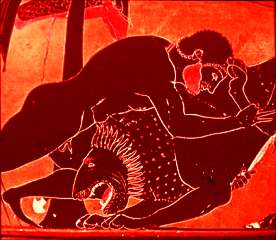
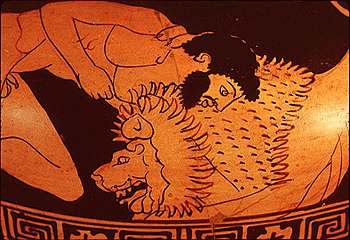
Hercules and the Lion of Nemea in a) black and b) red figure technique

A White Ground Technique Lekythos
Production, Technology Problems
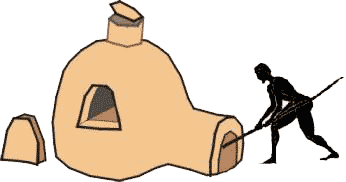
Preparing the fire for heating pottery in the kiln.
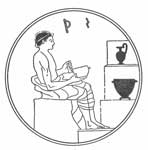
|
||
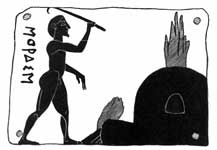 |
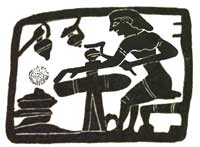 |
|
Click images to enlarge
RECONSTRUCTIONS AND REPRESENTATIONS OF POTTERY KILNS
While the Pottery material is terracotta red due to the Fe2O3 it contains it can be made black by heating it in a reducing atmosphere that produces FeO or Fe3O4 which is black (Using wet wood in the space where the material is heated it allows oxygen atoms to be removed from the material (reduction)). In order to prevent the black parts of the pottery to become red again they are covered with a special paint. This process requires that the temperature is at least 900 to 950 degree Celsius but not more than 1050 otherwise it will not work (a process called sintering that involves quartz particles in the “paint”). One has to consider that the Greeks had no thermometer but some say that the color of a heated material can be used to visually estimate accurately enough the temperature. The reduction could be done by not allowing air for some time inside the kiln, where the pottery was heated, producing a carbon monoxide atmosphere.
Athenian Vase Painting: Black- and Red-Figure Techniques
Techniques used in making and decorating Greek vases
Greek Vase construction animation

A vase painter in a potter's workshop.
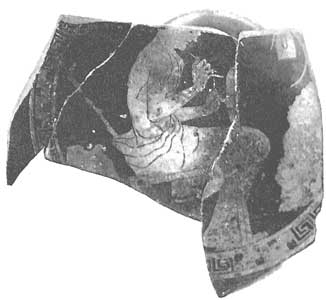
A pottery painting of pottery painting, Cylix Boston
Making Greek Vases (Video Presentations) Getty Museum
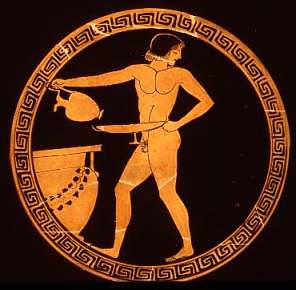
Mixing of wine and water in a Krater, probably here shown a oinochoos, a young slave, responsible for this in the symposia. It was a custom among the Greeks to mix water with their wine in so called Kraters. The usual proportion water to wine was 3, 2 or 1.5. Unmixed wine was called Akratos.
A Taste of the Ancient World: Symposium (More Utensils and examples)
Potters were probably more important than the painters. While we know often the Potter from the sign only occasionally also the painter name can be found.
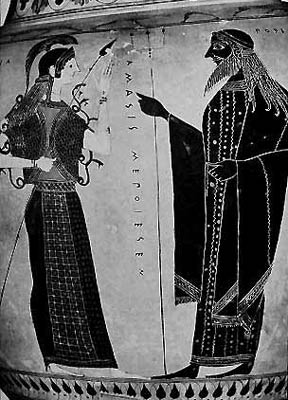
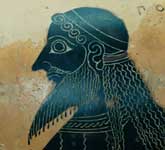
Poseidon, Amasis Painter CdM Luynes678
One very clear sign of the Artist for this example: We read the words Amasis me poiesen, i.e Amasis produced me. Also text is written describing who is who (painted labels, so-called dipinti)
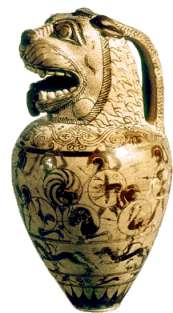
n Oriental Style Aryballos, 7th Century Corinth.
Information source
Ancient Greek Pottery with its decoration, showing mythological or real life scenes is an important source of ancient Greek culture. Since only a very small number of ancient Greek paintings survived it is the main “visual” source of ancient Greece.
An academic example: Forty Years of Theatre Research and its Future Directions , Greek Theater Research with information from Greek Pottery images. The artists would be surprised how their decorations are used by scholars.
Funny Pictures
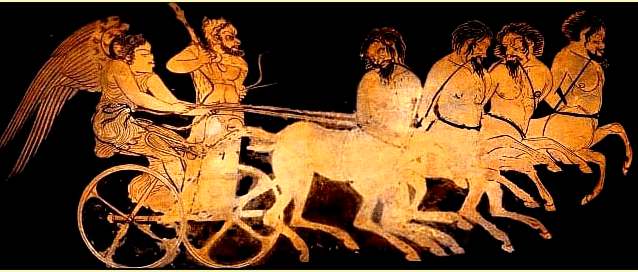
Nike and Hercules and a Centaur Quadriga (look at the barbaric faces of the Centaurs)

Pottery used by children (with the corresponding images of children learning to walk or playing)
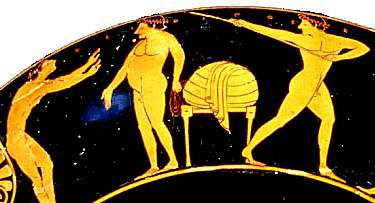
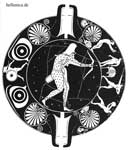
Psykter (Ψυκτήρ), Hoplites Riding Dolphins
detail, red-figure lekythos: Hera suckling Hercules while Aphrodite and Iris look on; Greek, c. 360-350 BC, London, British Museum. Credits: Barbara McManus, 1986
Examples of Mythology related Greek Pottery Paintings
Ancient Greek Painters (List of Painters and links to biographies and examples)
Pythagoras Cup of Justice
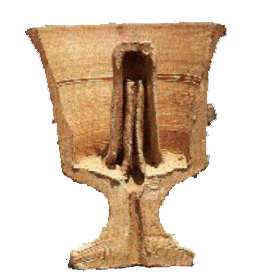
A Cup invented by Pythagoras. If the Cup was filled then an exterior tube in the center of the Cup was also filled through small holes in its bottom. When the level of the liquid in the Cup was above some mark then the liquid could flow through an inner tube allowing the liquid to escape the Cup. The result was that the Cup was emptied immediately by a “Suck Mechanism” as soon as the liquid level in the Cup exceeded the height of the inner tube. Pythagoras wanted to teach his students that they should be moderate. (Probably described also by Heron of Alexandria and known as Heron Cup or Tantalus Cup. Ref: Schlichting, H. J., Ucke, C., Der Trank aus dem Tantalusbecher, Physik in unserer Zeit 29 (1998) 174-176, in German. )
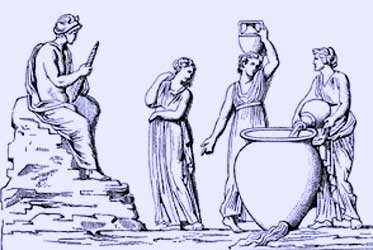
The Danaides Sisyphos task of "filling" a pithos with a hole.
Inscriptions (Επιγραφές)
I am the lekythos of Tateie; may whoever steals me be blind A Lekythos inscription, R. S. Stroud, "The Art of Writing in Ancient Greece," in W. M. Senner, ed. The Origins of Writing (Nebraska: University of Nebraska Press, 1989)
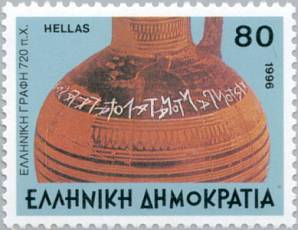
One of the first Greek symbols found on the Dipylon Oenochoe from 740-720 BC and inscription
hος νῦν ὀρχεστôν πάντον ἀταλότατα παίζει,
τô τόδε κλ[.]μιν[...]
Pottery related stories
According to a legend the first figurine in clay was produced by Boutades, a Sikyonian potter at Corinth thought to have lived before 657 BC. Boutades produced the figurine on behalf of his daughter, "who was in love with a young man; and she, when he was going abroad, drew in outline on the wall the shadow of his face thrown by a lamp. Her father, having pressed clay onto this, made a relief that he hardened by exposing it to fire along with the rest of his pottery" Pliny. Sources (Pliny 35. 151-152 and Athenagoras, Legatio pro Christianis 17) Antonio Corso, The Position of Portraiture in Early Hellenistic Art Criticism.
From a lecture: Solon ( 639-559 BC ) encouraged Athenian citizenship to skilled foreign craftsmen. He offered attractive conditions, including citizenship, to any skilled craftsmen who would settle in Athens; within a few decades Athenian potters had eclipsed those of Corinth." ... During the period 600-580 BC there was a striking development and the result due to Solon’s reforms according to Bailey was an increased export of Pottery."
B.L. Bailey, "The Export of Attic Black-Figure Ware," Journal of Hellenic Studies, LX (1940), pp. 60-70
Greek Vases: Images, Contexts and Controversies
Looking at Greek vases, Tom Rasmussen, Nigel Jonathan Spivey
The art of vase-painting in classical Athens, Martin Robertson
The development of Attic black-figure, John Davidson Beazley
Approaches to the study of Attic vases: Beazley and Pottier. Philippe Rouet
Greek vases in the San Antonio Museum of Art, Harvey Alan Shapiro, Carlos A. Picón, Gerry D. Scott
Greek vases in the J. Paul Getty Museum, Volume 6
Polygnotos and vase painting in classical Athens, Susan B. Matheson
Sotades: symbols of immortality on Greek vases, Herbert Hoffmann
Greek pottery: an introduction , Brian A. Sparkes
The red and the black: studies in Greek pottery, Brian A. Sparkes
Potter and patron in classical Athens
REMARKS
Looking for a particular pottery piece? Have a look in the Beazley database:
Athenian figure-decorated pottery: 630-300 BC designed for general use, for students and the wider public
http://www.beazley.ox.ac.uk/test/Vases/ASP/default.asp for academic research (registered users..)
http://www.cvaonline.org/cva/ProjectPages/CVA1.htm , Corpus Vasorum Antiquorum
Toby Schreiber , Athenian Vase Costruction: A Potter's Analysis-, J. Paul Getty Trust Publications (May, 1999) ISBN: 0892364653
John Boardman , Athenian Black Figure Vases: A Handbook (World of Art)- , Thames & Hudson; Reprint edition (February, 1985) ISBN: 0500201382
John Boardman , Early Greek Vase Painting: 11th-6th Centuries BC: A Handbook (World of Art)- Thames & Hudson (May, 1998) ISBN: 0500203091
John Boardman, Athenian Red Figure Vases: The Classical Period : A Handbook (World of Art)- , , Thames & Hudson (December 1989))
| Ancient Greece
Science, Technology , Medicine , Warfare, , Biographies , Life , Cities/Places/Maps , Arts , Literature , Philosophy ,Olympics, Mythology , History , Images Medieval Greece / Byzantine Empire Science, Technology, Arts, , Warfare , Literature, Biographies, Icons, History Modern Greece Cities, Islands, Regions, Fauna/Flora ,Biographies , History , Warfare, Science/Technology, Literature, Music , Arts , Film/Actors , Sport , Fashion --- |



